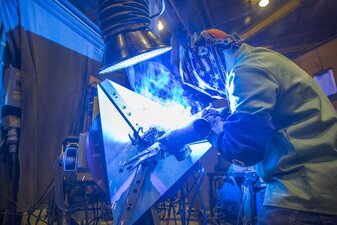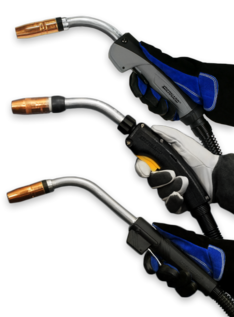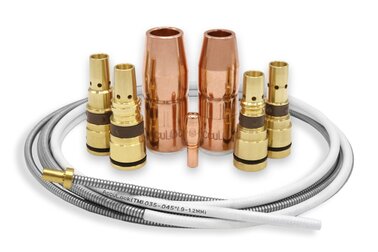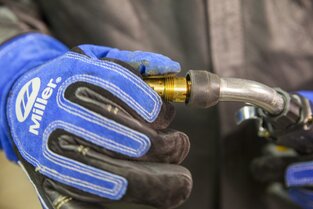Making a MIG Gun Last in Harsh Manufacturing Environments
Whether it’s a high amperage application, high or low ambient temperatures, or humidity, harsh manufacturing environments can be tough on welding equipment — including MIG guns and consumables. Confined, cluttered or dirty weld cells can also negatively affect this equipment.

Cleaning and organizing the weld cell, plus areas upstream and downstream, can help prevent some issues — for example, damage to welding gun cables caused by forklifts running over them. However, operators can’t change factors such as heat or cold or the amperage required for the job. For that reason, it’s important to look for a durable MIG welding gun and consumables and know how to protect them. Not only does that help minimize costs for replacement, but it also supports productivity by reducing downtime for changeover.
What to look for
One of the best defenses against the elements in a harsh manufacturing environment is to choose a MIG gun with robust components and make certain it’s the best option for the job. Consider these factors.
Duty cycle
This is the most important factor in selecting a MIG gun for any operation, but especially in a harsh environment. Duty cycle is the amount of arc-on time within a 10-minute period that a gun is capable of being used. Manufacturers in the U.S. rate their MIG welding guns according to the National Electrical Manufacturers Association (NEMA), with the rating reflecting the temperatures at which the gun or cable becomes too warm for use. For example, a gun may be rated at 400 amps and 100% duty cycle, meaning it can weld the entire 10 minutes at 400 amps (or even longer at a lower amperage) without discomfort to the operator.

In areas of high heat and humidity, it is helpful to use a MIG gun offering 100% duty cycle and higher amperages than needed for the application. If a welding shop is experiencing 80% humidity and it is 100 degrees F outside, that ambient temperature will reduce the duty cycle — a 400-amp gun may drop from 100% duty cycle to a 60% duty cycle range.
Handles
MIG gun handles should be manufactured with materials designed to withstand heat. Those with added glass in the plastic mold material are particularly adept at resisting wear in harsh environments. Tubular handles are also an option, as they tend to be a bit larger, and they have a slight air gap between the handle and the power cable that adds to its durability and heat tolerance. However, each handle material and design can have its own pros and cons. High glass content will create a more brittle handle, while more malleable materials may withstand less heat but not break as easily if abused.
Trigger
Trigger designs vary by manufacturer. The best option to protect against harsh elements is a micro-switch trigger, which is sealed. MIG guns with straight handles typically have a trigger that is enclosed to protect against dirt and debris. Avoid contact triggers, as these feature a spring and two contacts that touch each other when the operator presses down on it. Dirt can get inside of these triggers and break the contacts, preventing good electrical connections.
Neck
A MIG welding gun neck with aluminum armor on the outside is a durable choice. This type of neck is also lightweight, so it is more comfortable for the operator. MIG gun neck grips can also increase comfort, as well as control.

Power cable
Look for a power cable with a thick rubber outer jacket. While this type of cable may add some to its stiffness and weight, it will last longer. It can better take the abuse of being dragged on the floor, run over edges and exposed to hot materials. There are also power cable jackets that further protect power cables in harsh environments. A good jacket option is one with a tubular design versus one with Velcro or buttons. A power cable with higher-quality grades and higher amounts of copper adds to its durability and performance, as well.
Consumables
Welding contact tips, nozzles and gas diffusers made from quality copper or chrome zirconium are reliable complements to a sturdy MIG gun. Typically, higher-quality welding consumables cost more upfront; however, they last longer. Having fewer changeovers during shifts can save money for labor and replacement consumables in the long run. Contact tips, like those in AccuLock™ S consumable systems, have 60% of the tip buried within the gas diffuser. This keeps heat from the weld away from the tip, so it lasts longer. Shielding gas also cools the contact tip tail to protect it.
Maintain and protect
Preventive maintenance is critical in any welding operation, but especially in harsh manufacturing environments. Purchasing a gun that is repairable and can be maintained versus thrown away is a smart investment. In the long term, operators and maintenance personnel can gain more life from the gun even when exposed to heat, humidity and other elements.

Periodically, remove the welding gun liner and blow out any dust or debris that accumulated with compressed air. Take care not to drag the liner on the ground, where it can pick up more dirt or inadvertently become damaged.
At the start of every shift, especially when operators share MIG guns, check all connections. Tighten connections along the length of the gun — between the welding contact tip, gas diffuser, neck, power cable and power pin. Also check that the screws on the handle are tight and the trigger is functioning. When using a MIG welding gun with a rotatable neck, be certain to tighten it to avoid wire feeding problems.
Being mindful
The best defense to protect a MIG gun used in a harsh manufacturing environment is to make sure to select a durable one in the first place. Look for quality components and take care to schedule preventive maintenance. Treat the MIG welding gun just like any other piece of equipment in the welding operation, caring for it with regular inspections. Doing so can increase its lifespan and help prevent downtime and the cost for replacement.